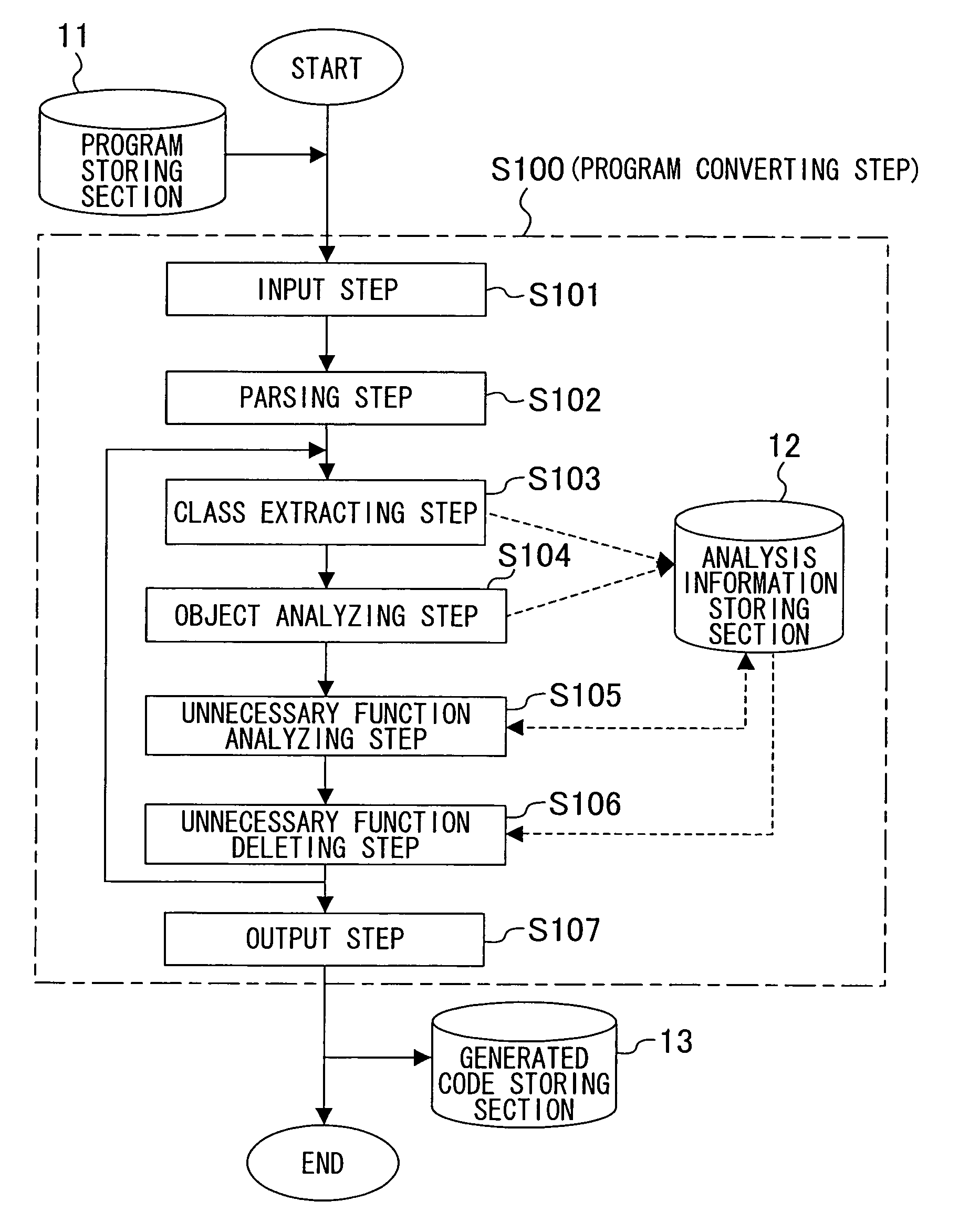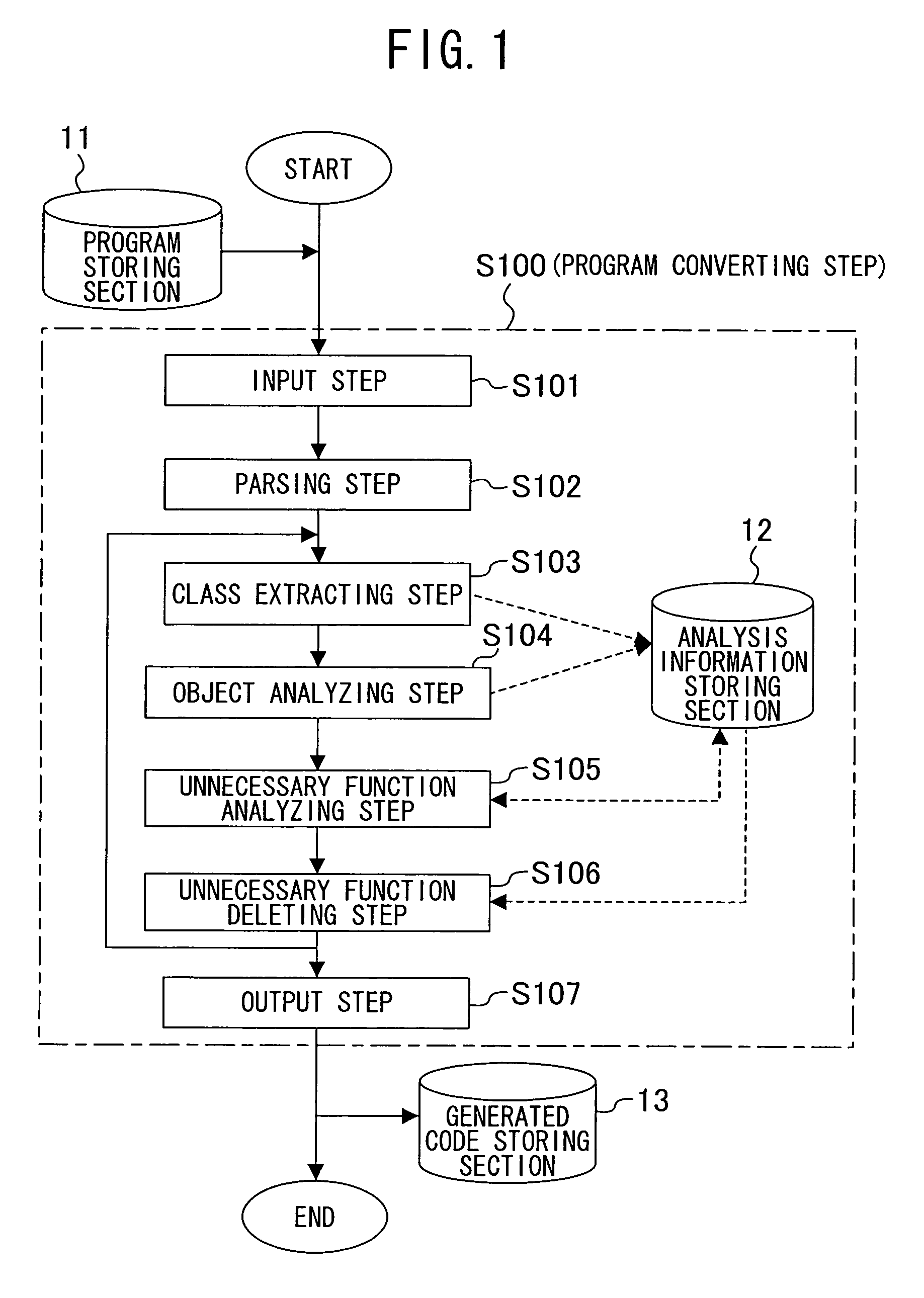Program converting method and storage medium
a technology of program converting and storage media, applied in the field of program converting method and storage media, can solve the problems of programming knowledge, difficult static analysis of which member function is called at compile time, and virtual functions which are not actually called not deleted
- Summary
- Abstract
- Description
- Claims
- Application Information
AI Technical Summary
Benefits of technology
Problems solved by technology
Method used
Image
Examples
embodiment 1
[0105]Hereinafter, a method for converting a program executed by a compiler (not shown) according to a first embodiment of the present invention will be described with reference to the drawings. In this program converting method, a program in which processing has been written is input to the compiler to make the compiler execute the processing. FIG. 1 is a flowchart showing a structure of a program converting step S100 according to the first embodiment.
[0106]As shown in FIG. 1, the program converting step S100 of this embodiment includes: an input step S101 of inputting a program to be converted; a parsing step S102 of parsing the program and generating a symbol table, a syntax tree and the like; a class extracting step S103 of recording information on classes included in the program in an analysis information storing section 12; an object analyzing step S104 of detecting classes whose objects are created out of the classes included in the program and of recording the result in the ...
embodiment 2
[0130]Hereinafter, a method for converting a program executed by a compiler (not shown) according to a second embodiment of the present invention will be described with reference to the drawings. In this program converting method, a program in which processing has been written is input to the compiler and to make the compiler execute the processing. FIG. 5 is a flowchart showing a structure of a program converting step S200 according to the second embodiment.
[0131]As shown in FIG. 5, the program converting step S200 of this embodiment includes: an input step S101 of inputting a program to be converted; a parsing step S102 of parsing the program and generating a symbol table, a syntax tree and the like; a class analyzing step S201 of extracting information on classes included in the program, analyzing definitions of classes, storing an inheritance relationship among the classes in an analysis information storing section 12; an object analyzing step S104 of detecting classes whose obj...
embodiment 3
[0157]Hereinafter, a method for converting a program executed by a compiler (not shown) according to a third embodiment of the present invention will be described with reference to the drawings. In this program converting method, a program in which processing has been written is input to the compiler to make the compiler execute the processing. FIG. 11 is a flowchart showing a structure of a program converting step S300 according to the third embodiment.
[0158]As shown in FIG. 11, the program converting step S300 of this embodiment includes: an input step S101 of inputting a program to be converted; a parsing step S102 of parsing the program and generating a symbol table, a syntax tree and the like; a class analyzing step S201 of extracting information on classes included in the program, extracting and analyzing a class definition and storing an inheritance relationship among the classes in an analysis information storing section 12; a virtual function analyzing step S301 of analyzin...
PUM
 Login to View More
Login to View More Abstract
Description
Claims
Application Information
 Login to View More
Login to View More - R&D
- Intellectual Property
- Life Sciences
- Materials
- Tech Scout
- Unparalleled Data Quality
- Higher Quality Content
- 60% Fewer Hallucinations
Browse by: Latest US Patents, China's latest patents, Technical Efficacy Thesaurus, Application Domain, Technology Topic, Popular Technical Reports.
© 2025 PatSnap. All rights reserved.Legal|Privacy policy|Modern Slavery Act Transparency Statement|Sitemap|About US| Contact US: help@patsnap.com



